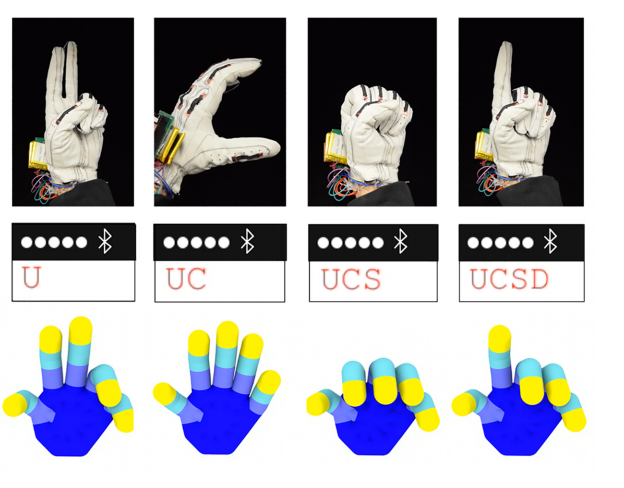Image: UCSD/PLOS One
The hand signals used by deaf English speakers, known as American Sign Language, is almost as old as the United States itself, but today it got a high-tech upgrade. As detailed in the journal PLOS One, researchers at UC San Diego have developed a low-cost smart glove that automatically translates the American Sign Language (ASL) alphabet into digital text.The glove was created using less than $100 worth of components and consists of two flexible strain sensors on each finger and one sensor on the thumb. These sensors measure the change in electrical resistance based on changes in applied force to the sensor when a finger is moved.When a user signs with the gloves on, each letter in the ASL alphabet results in a different combination of electrical resistance. Based on these variances, a small computer mounted on the glove is able to tell which letter the wearer is signing. This information is then relayed via Bluetooth to a smartphone or computer to automatically convert the sign letters into readable text. Although this glove isn't the first piece of technology to attempt to translate sign language into text in real-time, according to the researchers it is the most versatile. Most motion sensing technologies use at least one camera and some type of infrared transmitter to track motion, which tends to make these technologies prohibitively expensive and immobile.Considering that it was made with less than $100 worth of parts and doesn't require any cameras or infrared sensors, the ASL smart glove is a promising interface between the deaf and those who aren't fluent in ASL. But according to the researchers, the glove's use as an ASL translator is only the beginning.Since each letter signed by the glove is used to manipulate a virtual hand that mirrors that letter, the researchers also see the glove as an interface for virtual environments. This means it could find use in everything from VR video games to remotely operating a drone.Get six of our favorite Motherboard stories every day by signing up for our newsletter.
Although this glove isn't the first piece of technology to attempt to translate sign language into text in real-time, according to the researchers it is the most versatile. Most motion sensing technologies use at least one camera and some type of infrared transmitter to track motion, which tends to make these technologies prohibitively expensive and immobile.Considering that it was made with less than $100 worth of parts and doesn't require any cameras or infrared sensors, the ASL smart glove is a promising interface between the deaf and those who aren't fluent in ASL. But according to the researchers, the glove's use as an ASL translator is only the beginning.Since each letter signed by the glove is used to manipulate a virtual hand that mirrors that letter, the researchers also see the glove as an interface for virtual environments. This means it could find use in everything from VR video games to remotely operating a drone.Get six of our favorite Motherboard stories every day by signing up for our newsletter.
Advertisement

